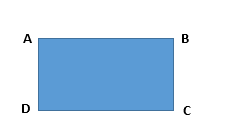CONTENT LIST
What is quadrilateral?
Quadrilateral word is derived from the Latin words 'quadri,'which means four, and 'latus', which means side.
A quadrilateral is a polygon of four sides, four angles, and four vertices.
Cards, chess boards, traffic signs, etc. are real life objects of quadrilateral shape.
Parts of a quadrilateral
- Four angles of quadrilateral ABCD are ∠A, ∠B, ∠C, and ∠D .
- Four sides of quadrilateral ABCD are AB, BC, CD, and DA.
- Four vertex of quadrilateral ABCD are A, B, C, and D.
- Two diagonals of quadrilateral ABCD are AC and BD .
Angle sum property of quadrilateral.
The sum of the four angles of a quadrilateral is 360°
If ABCD is a quadrilateral then
∠A+∠B+∠C+ ∠D=360°
Various types of quadrilateral.
Quadrilaterals can be classified into categories that are Parallelograms, Squares, Rectangles, Trapezium Rhombuses and Kite.
Parallelogram: A quadrilateral with both pairs of opposite sides parallel is called parallelograms.
Square: A parallelogram having all sides equal and one angle at a right angle is called square.
Rectangle: A parallelogram with one angle at a right angle is called a rectangle.
Trapezium: A quadrilateral with at least one pair of opposite sides parallel is called trapezium.
Rhombus: A parallelogram having all sides equal is called rhombus.
Kite: A quadrilateral with two pairs of adjacent sides equal, but opposite sides are not parallel, is kite.
Concave & Convex quadrilaterals
Concave quadrilaterals: In concave quadrilaterals, any one interior angle is greater than 180°.
The line segment joining the vertices is not a part of the same region of the quadrilateral.
Convex quadrilaterals: In convex quadrilaterals, each interior angle is less than 180°.
A quadrilateral is convex if the line segment joining any of its two vertices is in the same region.
Properties of a Parallelogram
Theorem : A diagonal of a parallelogram divides it into two congruent triangles.
Theorem : In a parallelogram, opposite sides are equal.
Theorem : If each pair of opposite sides of a quadrilateral is equal, then it
is a parallelogram.Theorem : In a parallelogram, opposite angles are equal.
Theorem : The diagonals of a parallelogram
bisect each other.Theorem : If the diagonals of a quadrilateral bisect each other, then it is a parallelogram.
Theorem : A quadrilateral is a parallelogram if a pair of opposite sides is
equal and parallel.Condition for a Quadrilateral to be a Parallelogram
(i) Each pair of opposite sides are parallel.
(ii) Each pair of opposite sides are equal.
(iii) Each pair of opposite angles are equal.
(iv) Diagonals bisect each other.
(v) One pair of opposite sides are parallel and equal.
The Mid-point Theorem
A line segment joining the midpoint of any two sides of the triangle is parallel to its third side and is also half of the length of the third side.
Converse of Mid-Point Theorem
The line drawn through the mid-point of one side of a triangle parallel to the base of a triangle bisects the third side of the triangle.
More about quadriletral
- Sum of the angles of a quadrilateral is 360°.
- A diagonal of a parallelogram divides it into two congruent triangles.
- Two opposite angles of a parallelogram are equal.
- The diagonals of a parallelogram bisects each other.
- In a parallelogram, the bisectors of any two consecutive angles intersect at right angle.
- If a diagonal of a parallelogram bisects one of the angles of the parallelogram it also bisects the second angle.
- The angles bisectors of a parallelogram form a rectangle.
- A quadrilateral is a parallelogram if its opposite sides are equal.
- A quadrilateral is a parallelogram if its opposite angles are equal.
- The diagonals of a quadriletral bisect each other, if its a parallelogram.
- A quadrilateral is a prallelogram if its one pair of opposite sides are equal and parallel.
- Each of the four angles of a rectangle are right angle.
- Each of the four angles of a rhombus are of the same length.
- The diagonal of a rectangle are of equal length.
- Diagonals of a parallelogram are equal if and only if it is a rhombus.
- The diagonals of rhombus are equal and perpendicular to each other.
- Diagonals of a parallelogram are perpendicular if and only if it is a rhombus.
- The diagonals of a square are equal and perpendicular to each other.
- If the diagonals of a parallelogram are equal and intersect at right angles, then it is a square.
- The line segment joining the mid-points of any two sides of a triangle is parallel to the third side and equal to half of it.
- A line through the mid-point of a side of a triangle parallel to another side bisects the third side.
- The quadrilateral formed by joining the mid-points of the sides of quadrilateral,in order, is a parallelogram.







